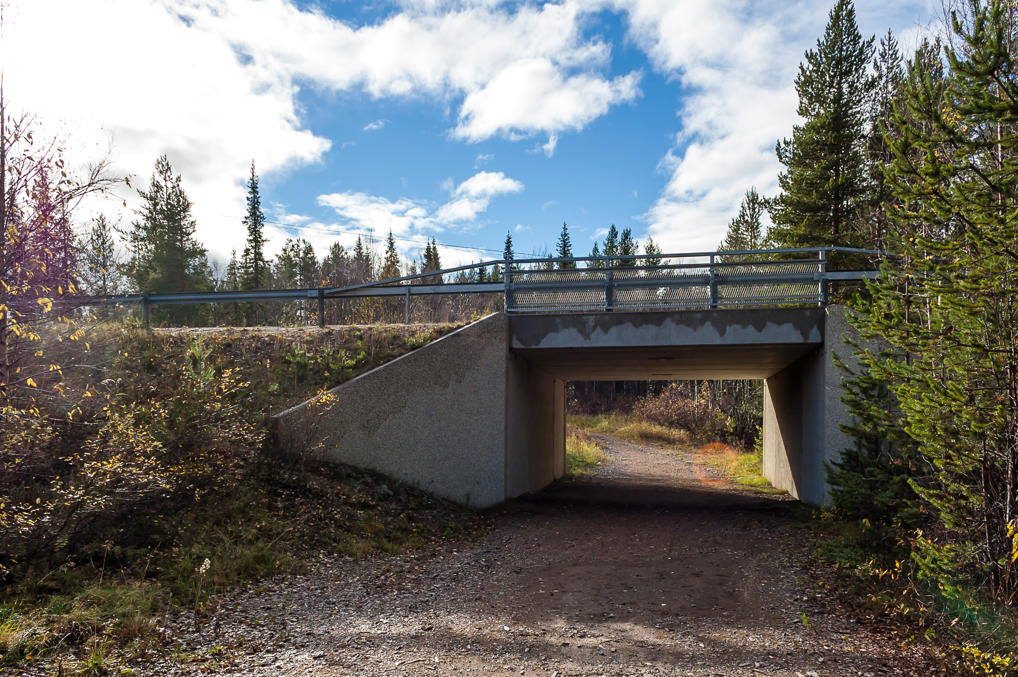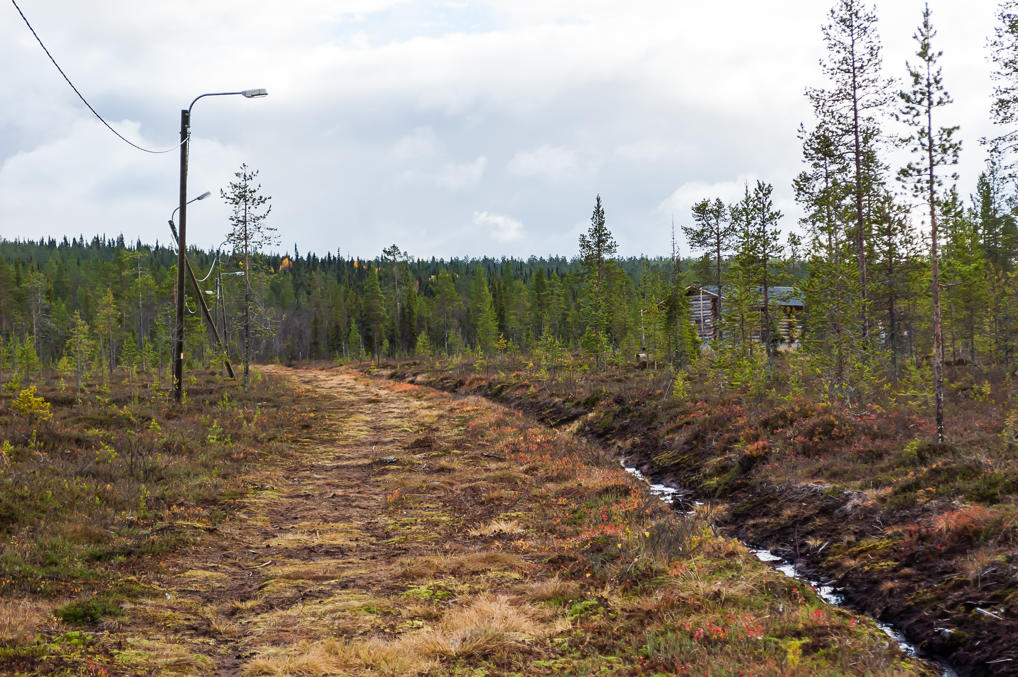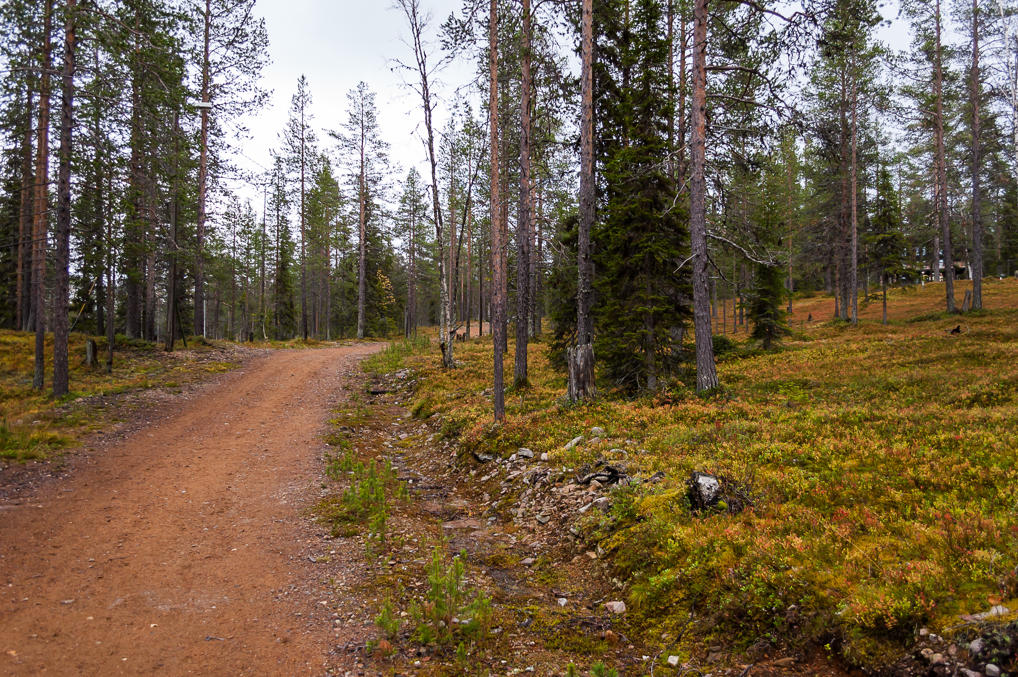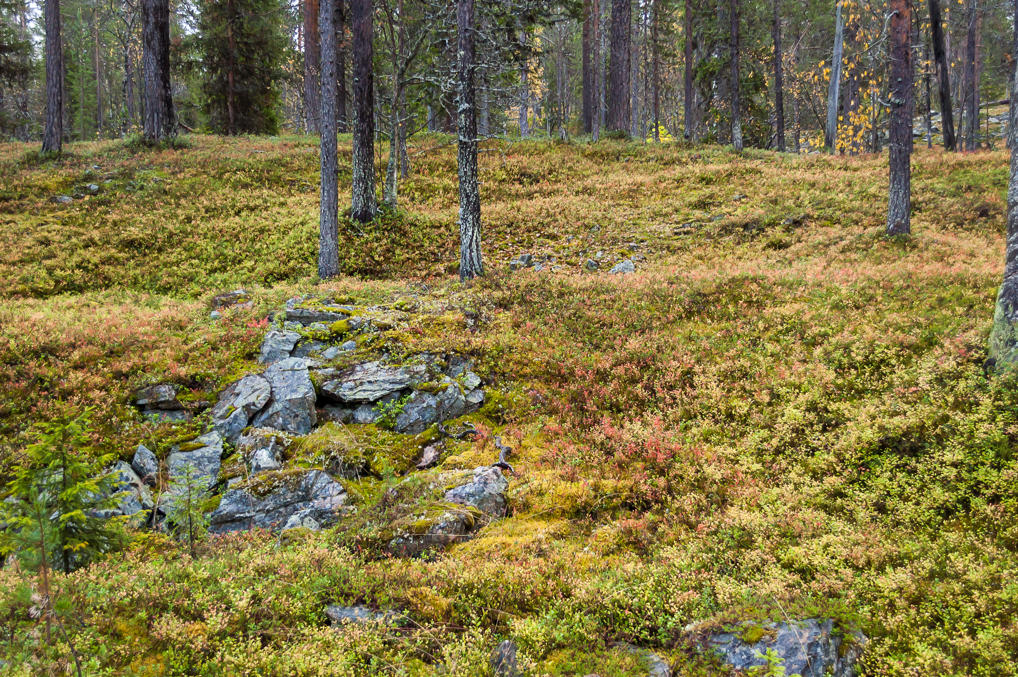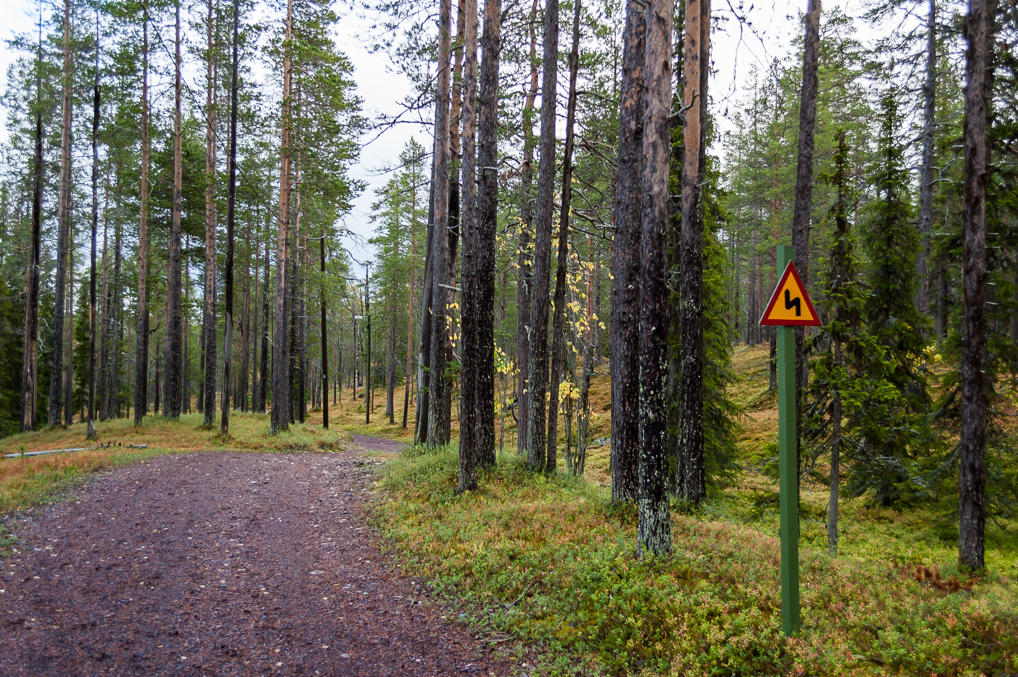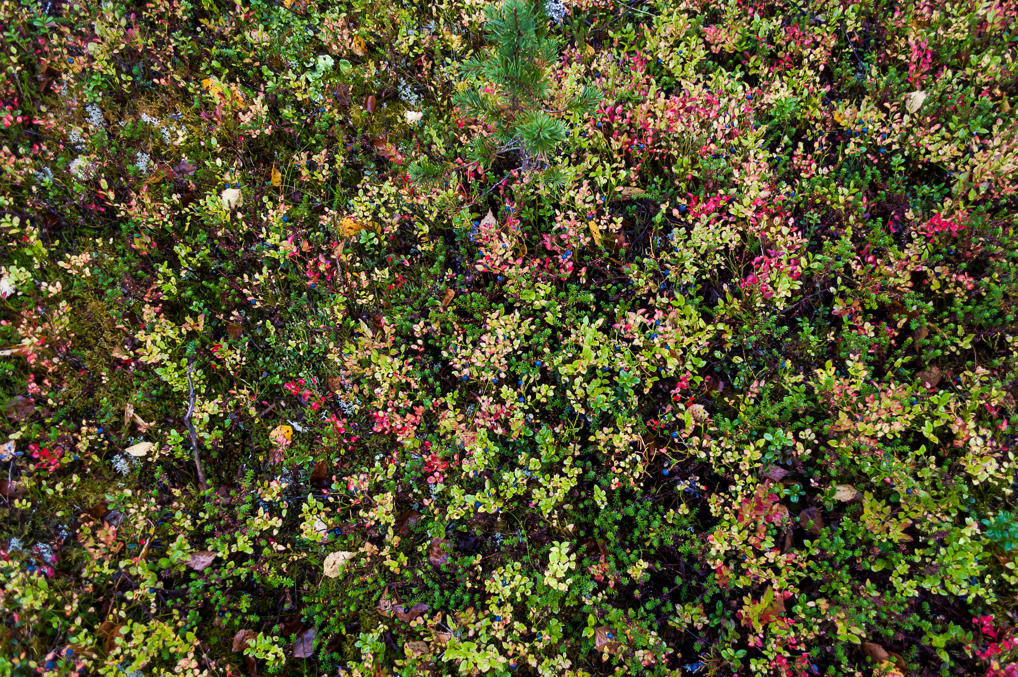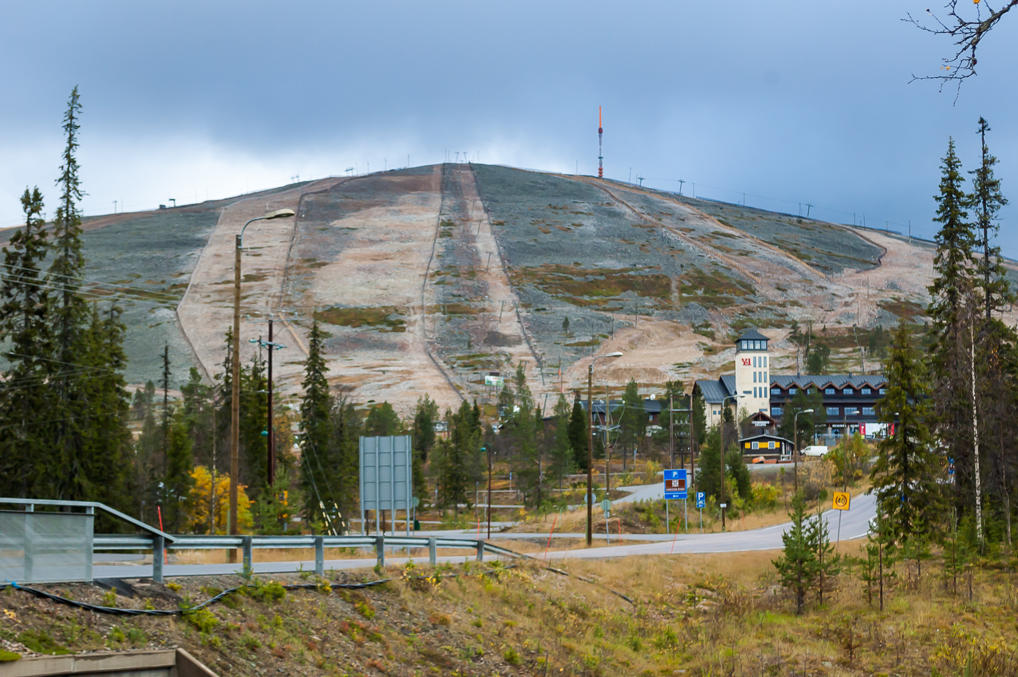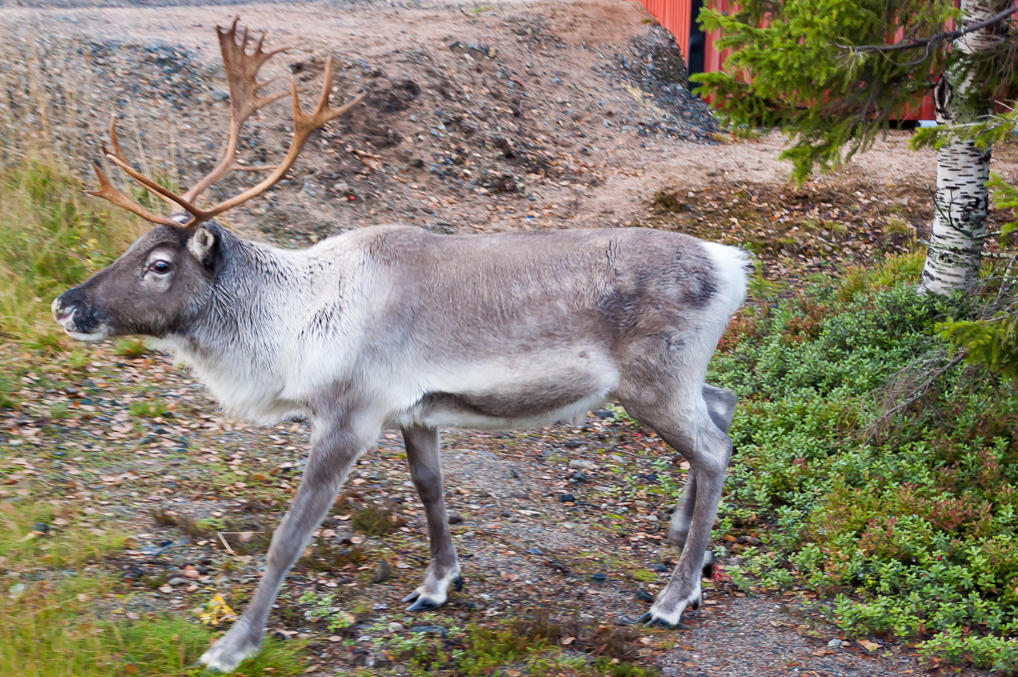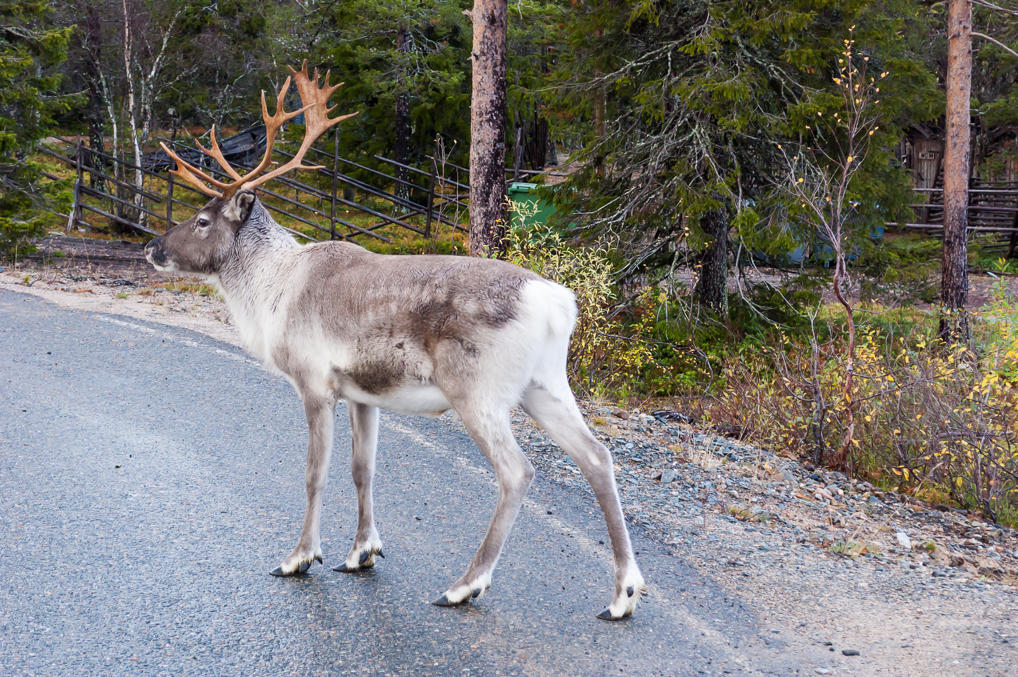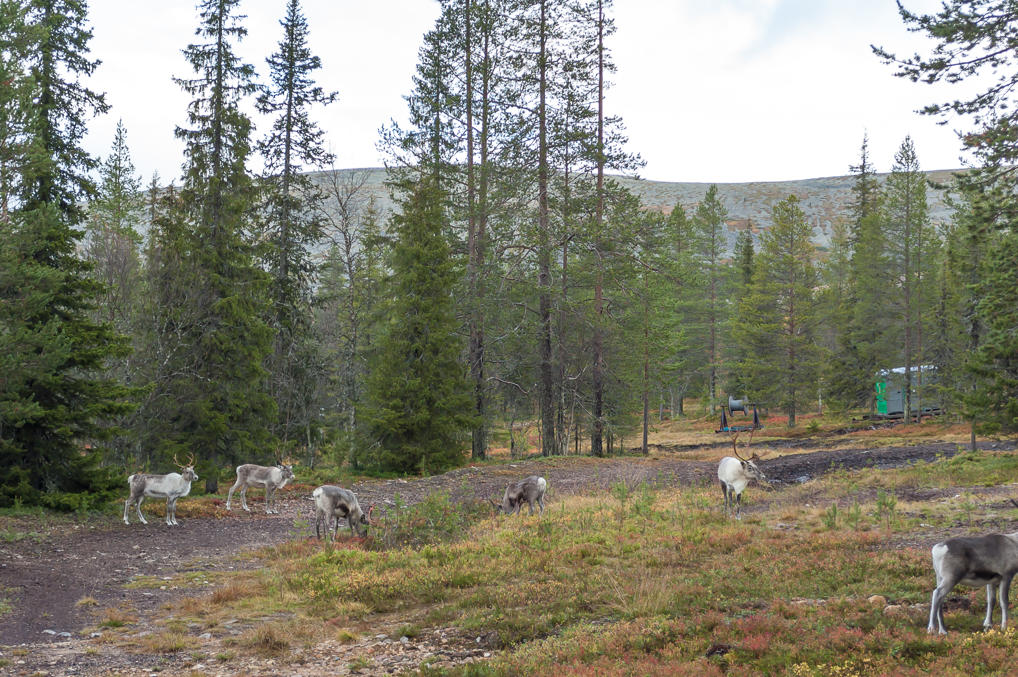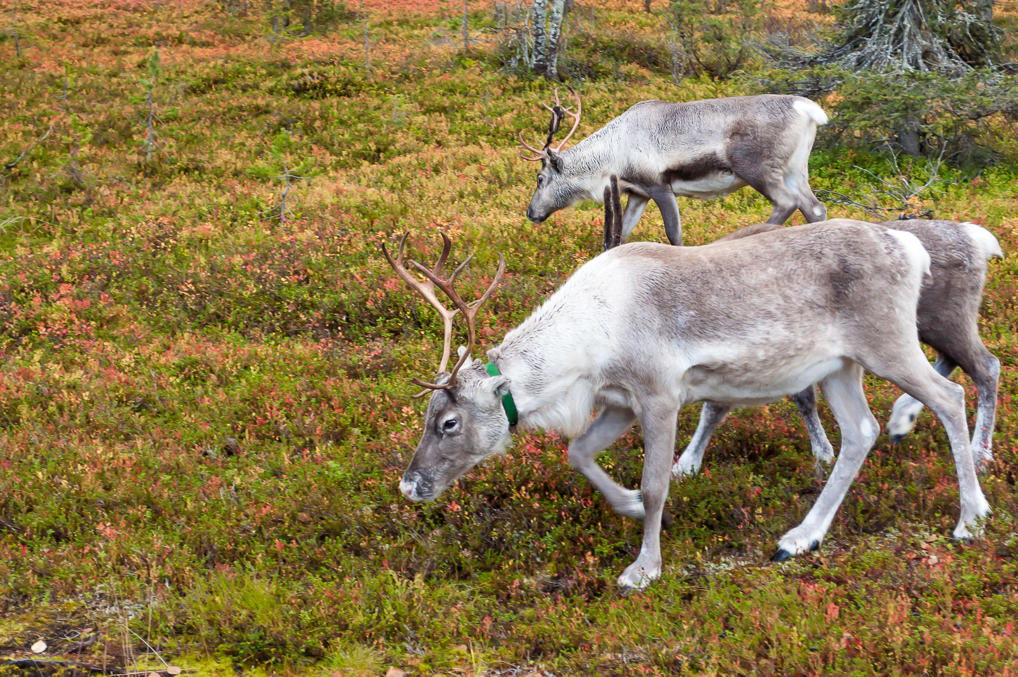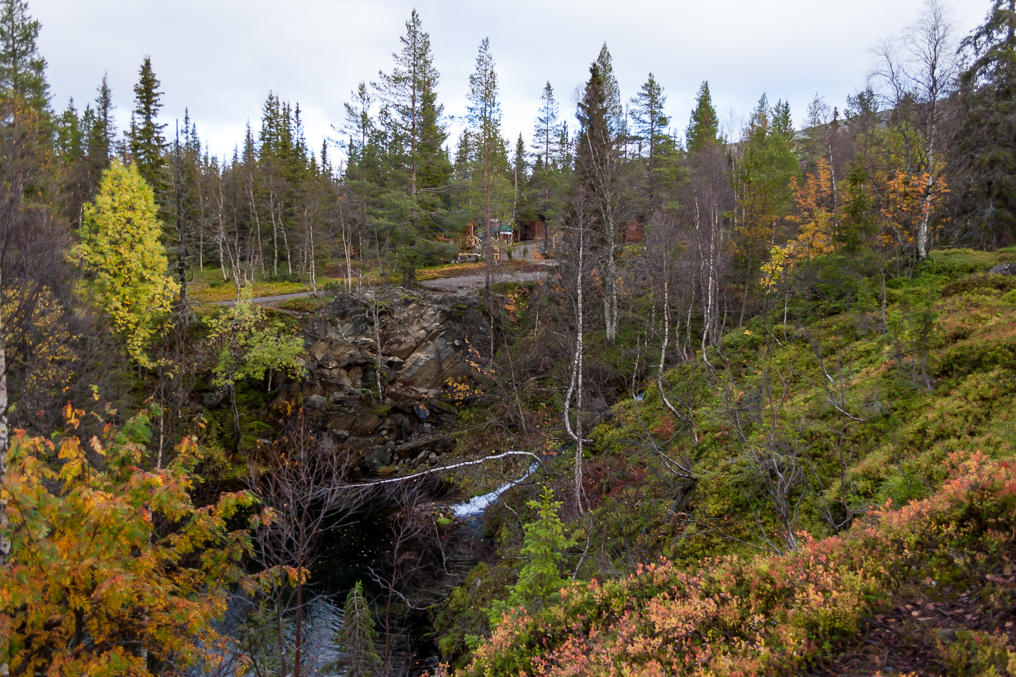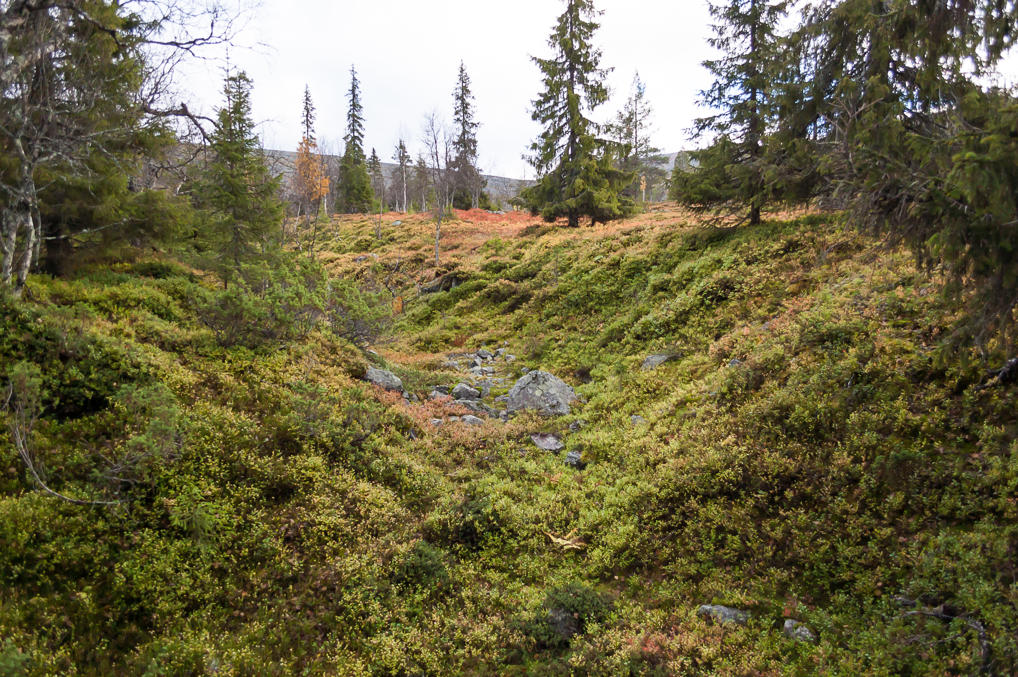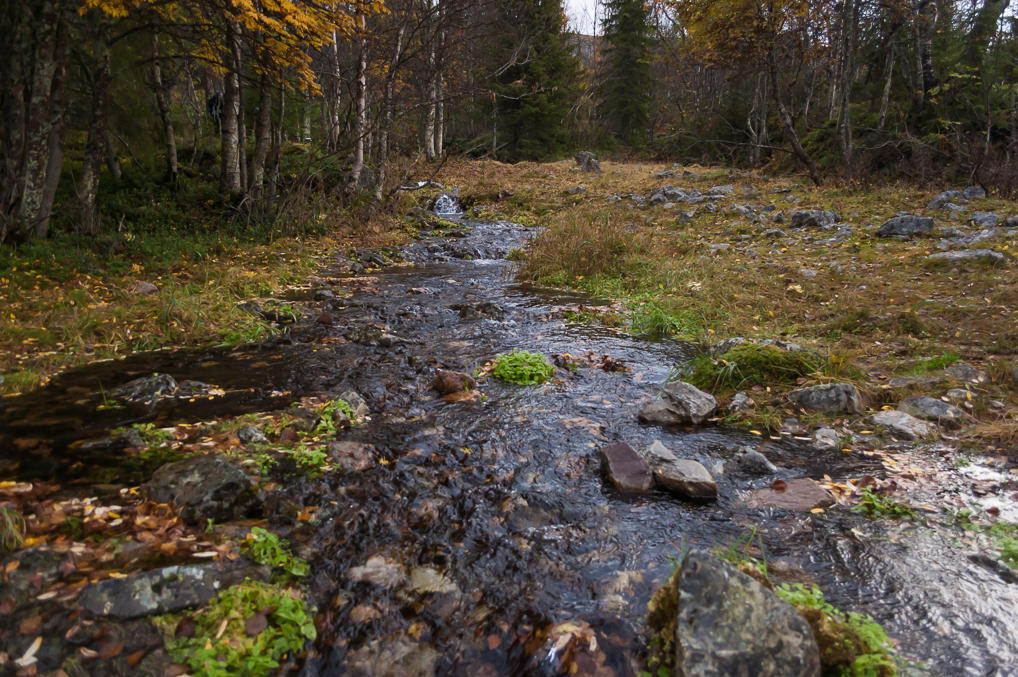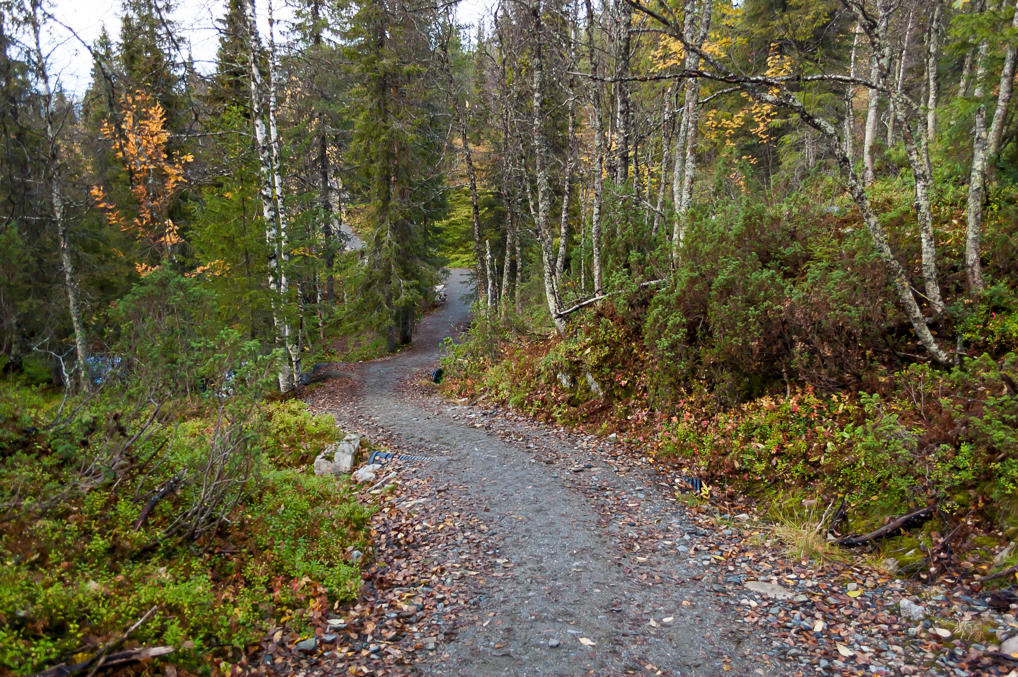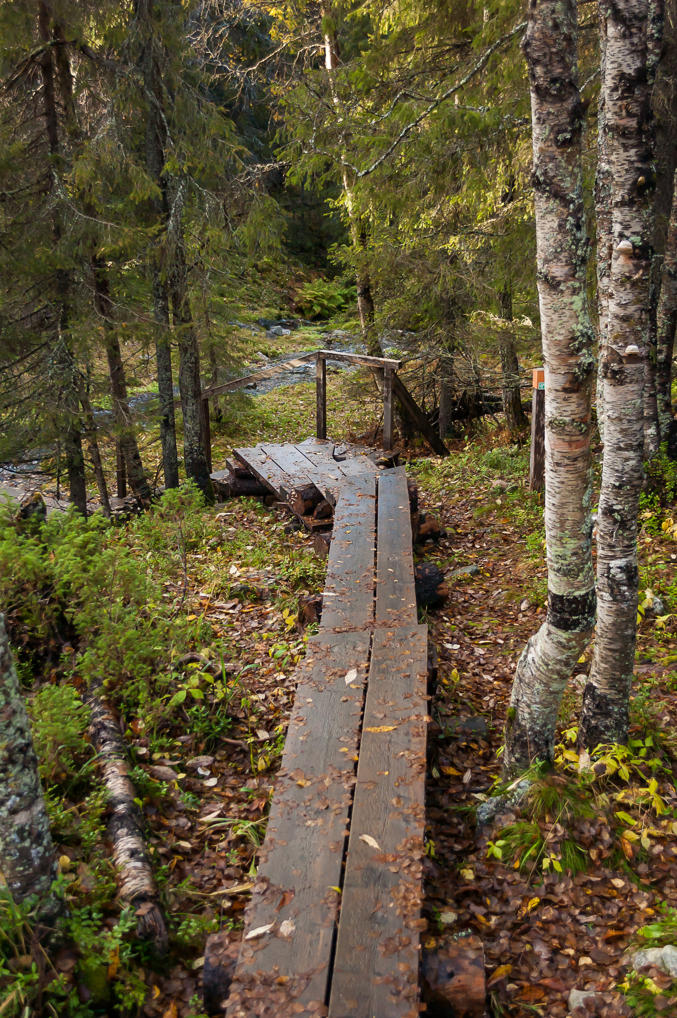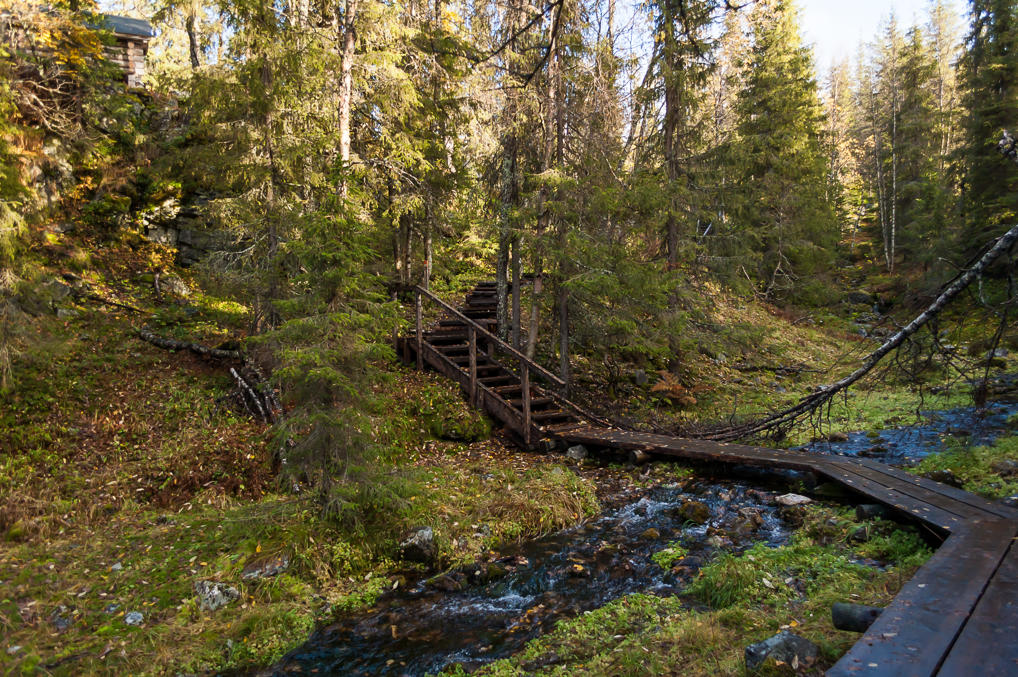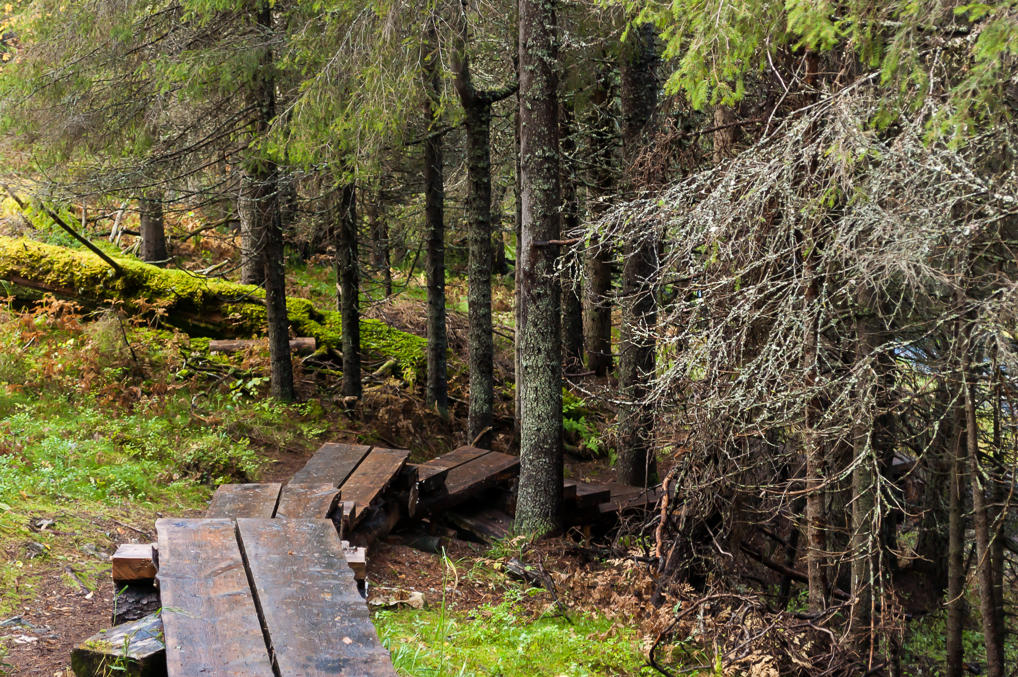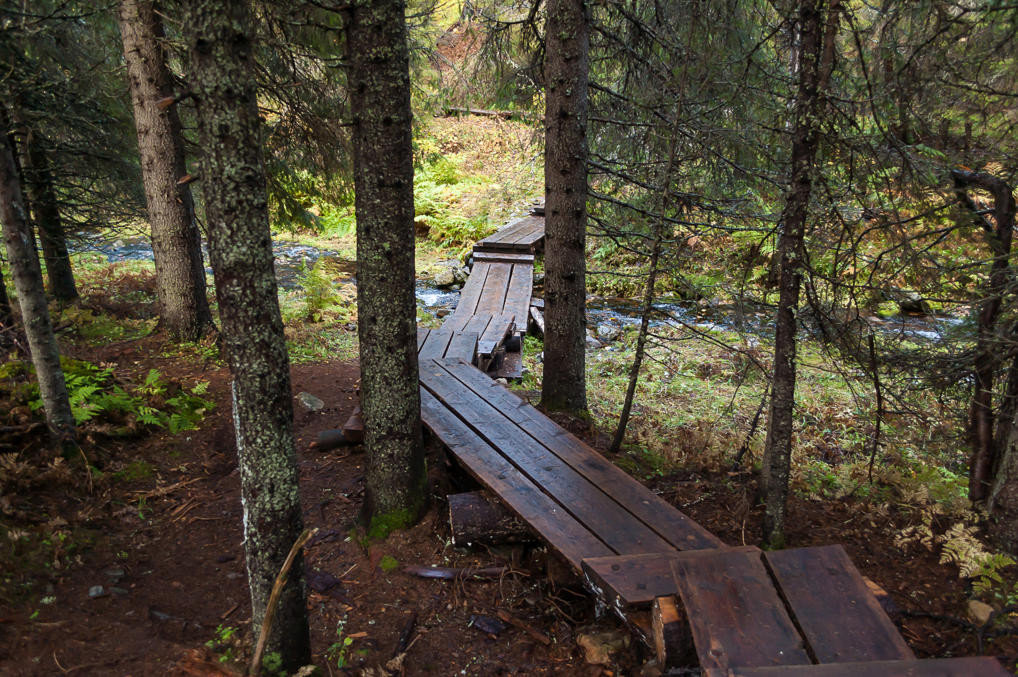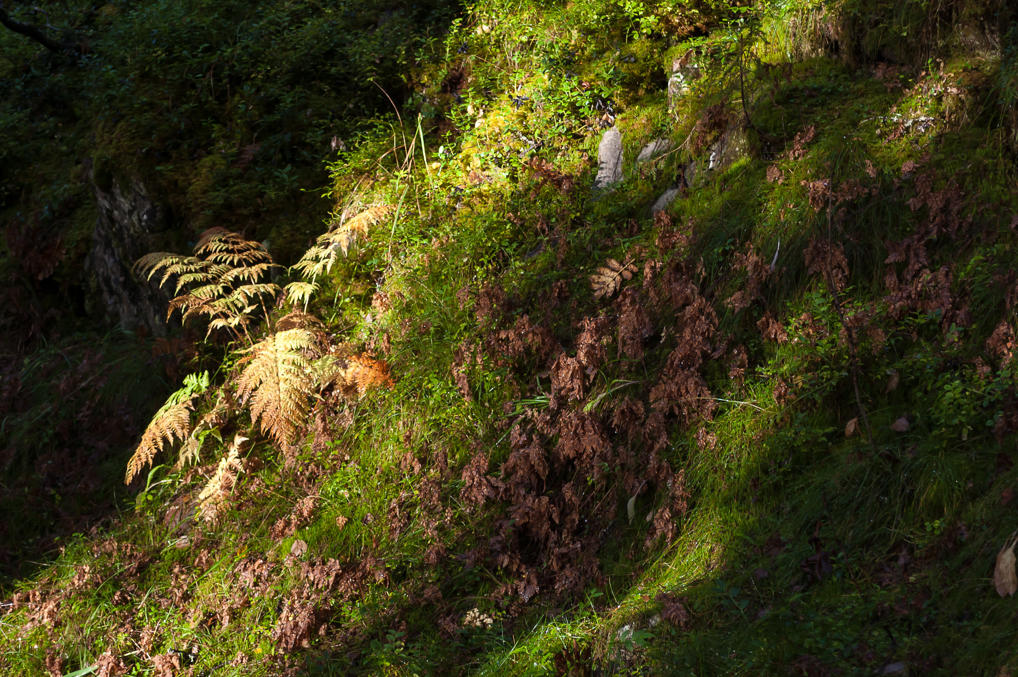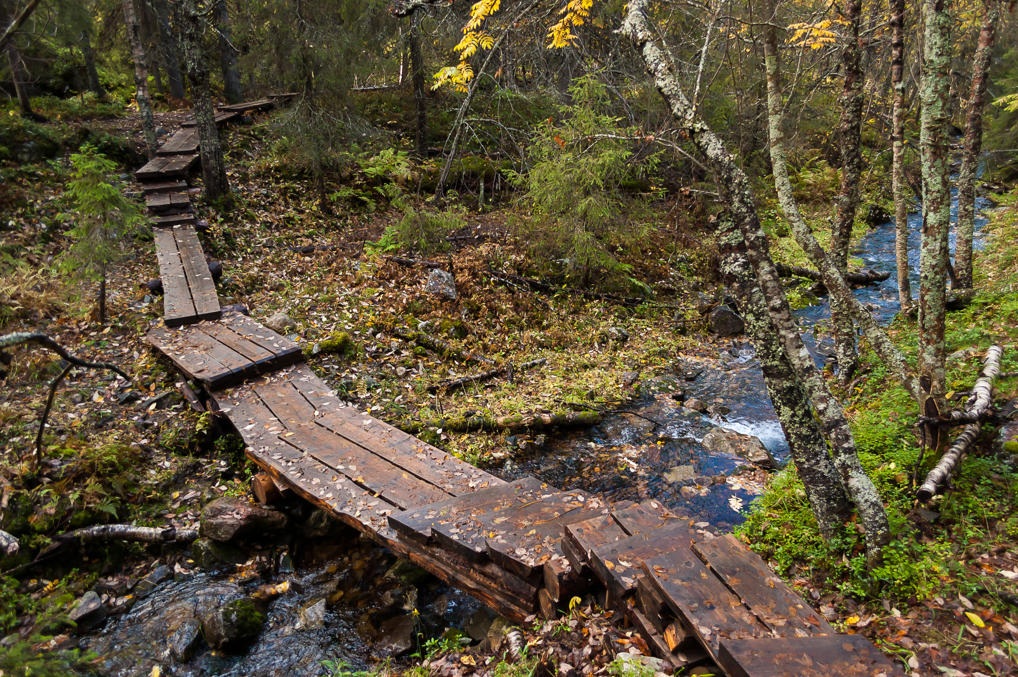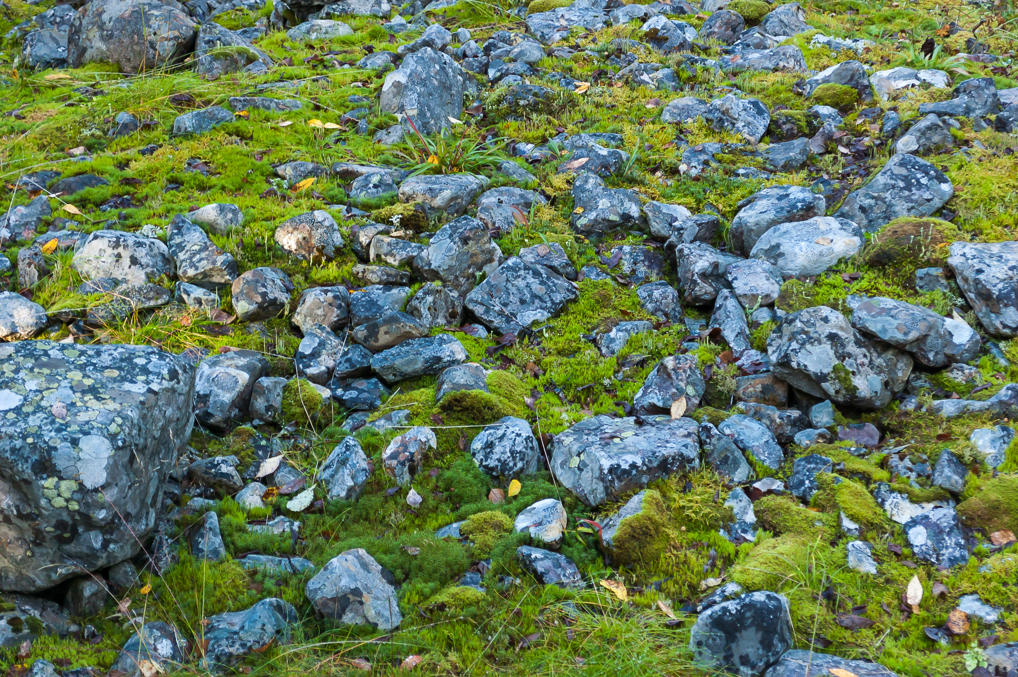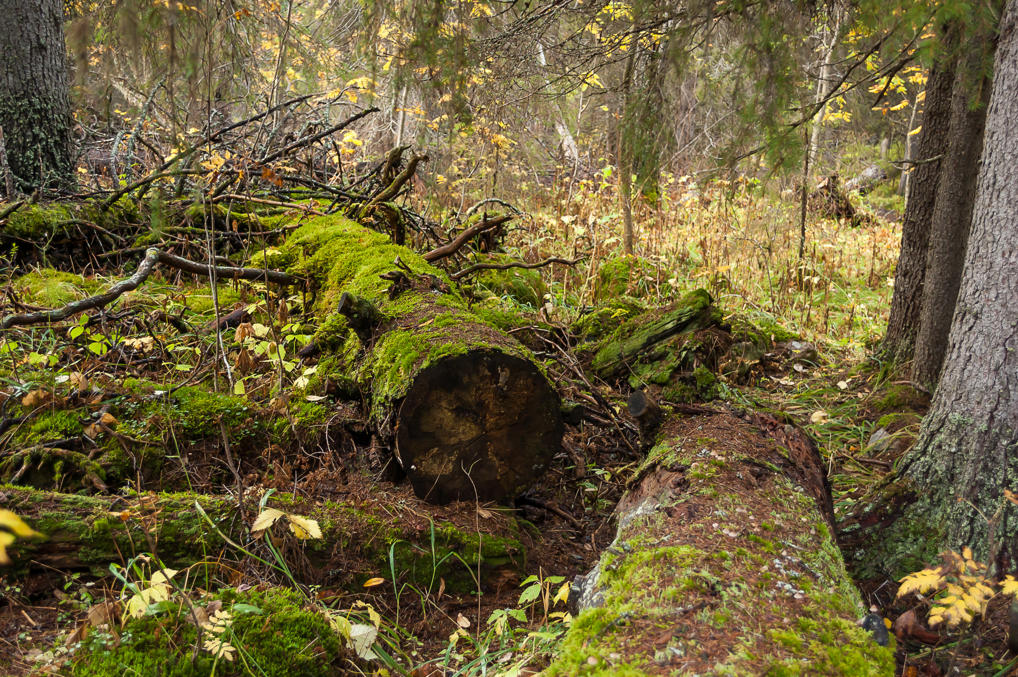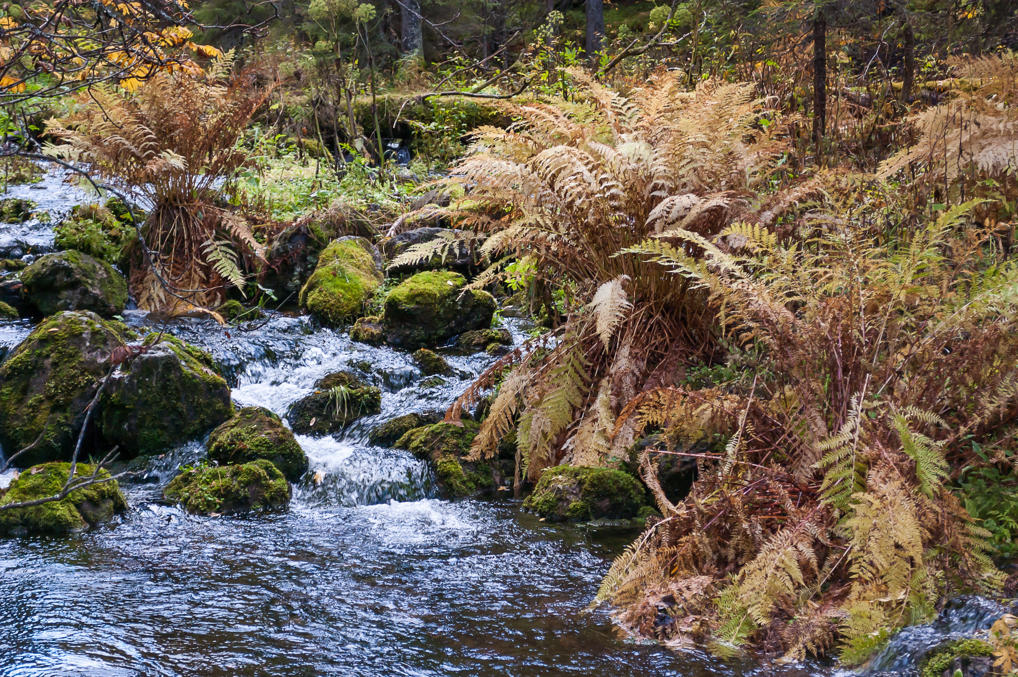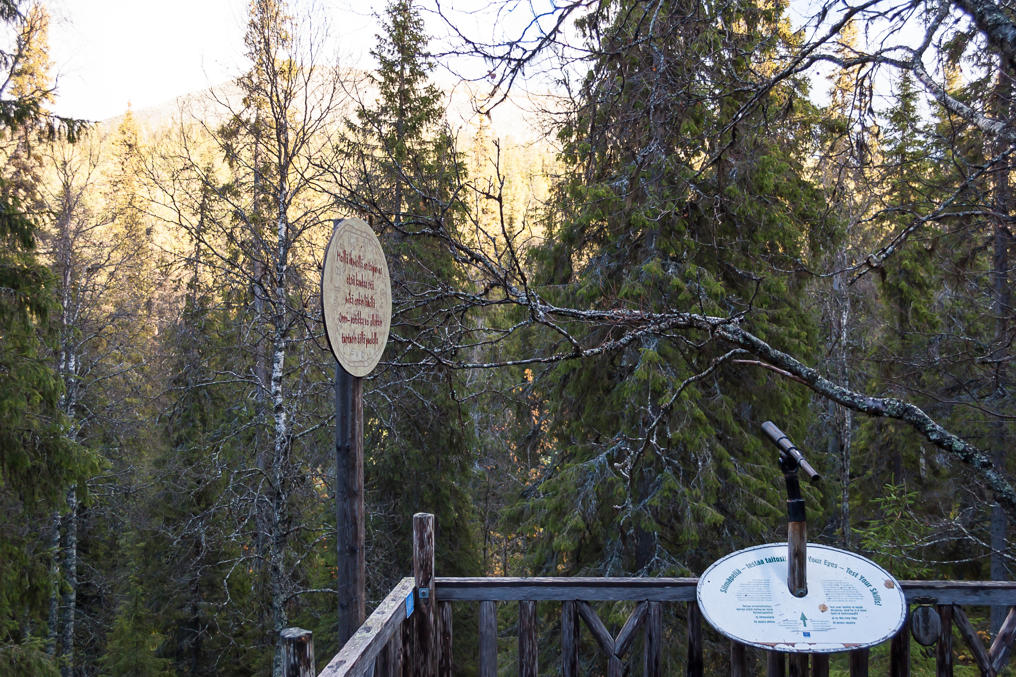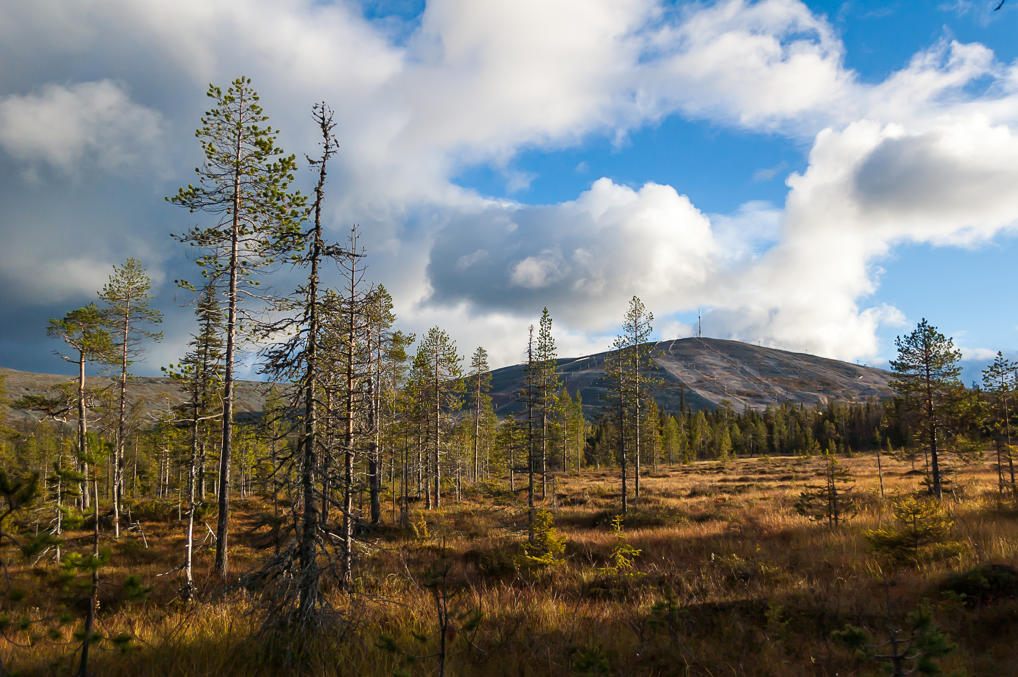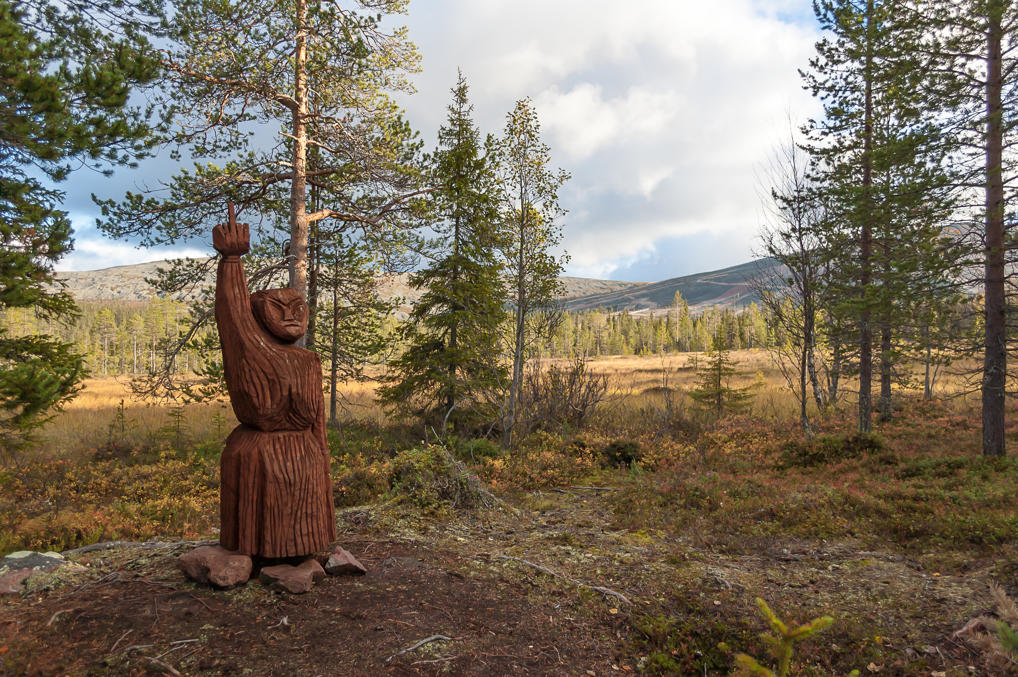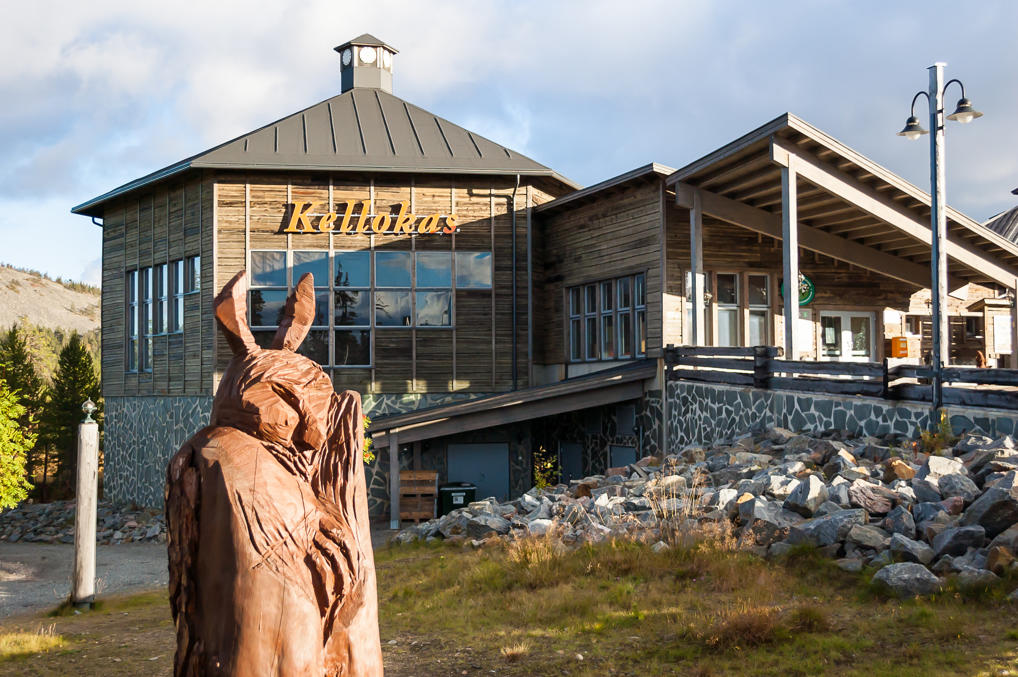So, after finding a hiking trail in Äkäslompolo, I soon reached a crossroads with some pointers:
1. Äkäshotelli, presumably a hotel, seems to be the place in Äkäslompolo where most local trails start. Other destinations I had some idea about were Tunturi-Ylläs (Ylläs Fell, presumably), Kellokas (nature center whether some other trails start), and Ylläsjärvi (village on the other side of Ylläs Fell). I decided I wanted to see Ylläs and walked to the left.
2. This trail goes through a few underpasses under Tunturintie and other roads. Safety first.
3. One of the stretches close to Äkäslompolo passes through some wet though walkable terrain. It looks like this trail is more commonly used as a skiing track in winter.
4. After the wet stretch ended, I saw two women in their thirties on bikes ahead. As the trail started to go uphill, they went slowly and stopped often and I passed them several times. By the third time I felt somewhat awkward and ended up waiting a bit behind a bend myself so that they may ride ahead. #MildlySociallyAwkwardPeopleProblems
5. The trail itself entered the forest and became wide and dry, apparently covered with sawdust.
6. I loved the carpet of vegetation in this forest, low and thick and touched with yellow and red already. Here and there heaps of greenish blue (actually greyish blue and covered with large patches of light green lichen) stones peeked through grass. I'm used to big granite boulders in Karelian forests, but these are very different, being much smaller and brighter.
7. There are even some road signs for skiers, just like real ones, but several times smaller.
8. The vegetation is basically blueberries and moss. Too bad I'm not a great fan of berries.
9. I emerged out of this forest by the Tunturintie again, very close to Ylläs skiing slopes. The skiing center is pretty huge, but of course it looks almost completely deserted in snowless season. It's even sort of sad.
10. A nice big map on an information board. It shows Äkäslompolo, all the surrounding fells (as brownish patches), and all the hiking trails (thick orange and other lines).
11. Walking idly on the skiing center parking lot, I saw a reindeer all of a sudden! I was able to get close to this guy easily.
12. Reindeer are of course traditionally associated with Lapland and the North in general, and rightly so. Unless you spend your entire vacation in a hotel, you're extremely likely to see some herd or two near any Lapland village. All reindeer in Lapland are domestic animals, and are owned and herded by someone. Although I'm not sure how this works; I never saw any person near them. In the Nordic countries wild reindeer only remain in the isolated mountains of Southern Norway.
13. Reindeer were traditionally herded by the Sami for their meat, fur, milk, antlers, and as pack animals. Come to think of it, there's not much else to eat in the North. Well there is fish in lakes, and also berries, but that's about it. In Sweden and Norway only Sami are still allowed to keep reindeer; there is no such limitation in Finland. Of course nowadays Lapland is quite civilized, with roads, electricity, supermarkets, and modern housing, and probably no one really needs to keep reindeer to survive. Still, this remains a traditional occupation for the Sami. Reindeer are also very popular with tourists. If you go to Lapland in winter, trying reindeer sledding is probably a must.
It's kind of a philosophical question whether it is worth it to continue doing reindeer herding even if it does not really make economic sense anymore. The state provides subsidies to herders, although these are not awfully great, just 15% of their expenses or so.
14. Anyway, reindeer are very beautiful animals. They aren't very large, the largest being the size of a pony, and many are more like a very big dog. Unlike regular deer and moose, female reindeer sport antlers too. They shed them once a year, and those with smaller antlers may have them still covered by skin. At least this herd of about twenty looks to be in excellent health. They are all very clean and do not smell at all.
I read about reindeer before embarking on my trip — first of all, I checked whether they have been known to attack humans in any cases. Apparently this is pretty much unheard of. They are very docile and really, for all their beauty and grace, they behave pretty much exactly like cows. Instead of mooing they make funny snorting sounds, but otherwise they wander around, munch on grass, and ignore almost everything around them in exactly the same way. There's a lot of stuff they will eat, including grass, leaves, berries, and mushrooms, but their favorite snack is reindeer lichen. It doesn't look very tasty but reindeer digestive system is adapted to extract a lot of of nutrients from it, and there's a lot of this lichen around in Lapland.
15. After admiring the reindeer herd, I walked on a trail marked as Varkaankuru. Varkaankuru is one of the shortest and most accessible nature trails around Äkäslompolo. I remembered this name from some website about Lapland.
In general, trails in Finland and likely other Nordic countries are divided into nature trails and hiking trails. Nature trails are meant for coming with all your family and exploring in an afternoon and maybe even having a picnic. They can be from 0.5 to about 8 km long. They are usually named and very clearly marked, easy to walk with no wet stretches or anything, and often have some information boards along the way. So in other words they are intended for more casual audience, being easy enough to accomodate even children, dogs, and sometimes even disabled people.
Hiking trails, on the other hand, may be tens or even hundreds of kilometers long. They are often less thoroughly marked, and may have difficult terrain or obstacles such as minor rivers. They are meant for more serious tourists, with backpacks and tents. (I would also add a "connecting" trail type to these two; that would be relatively short trails which simply connect some destinations without claiming to be particularly special in any way. The trail I walked from Äkäslompolo to Ylläs would qualify as one.) Varkaankuru thus is a typical nature trail, at 4 km.
16. Soon enough I heard sound of rushing water. Varkaankuru means Thief's Ravine (I wonder what's the story behind this name) but it's really not much of a ravine; it is actually a tiny valley of a tiny Varkaanoja brook, which flows where slopes of Ylläs and adjoining Kelostapuli fells meet. The valley is covered with unusually lush forest. My understanding is that Varkaankuru landscape isn't really typical of Lapland, but it's certainly a very pretty trail.
Coming from the skiing center (you're actually supposed to walk Varkaankuru in the opposite direction, starting at Kellokas nature center), the trail reaches Varkaankuru at a small pond named Varkaanlampi. There you cross the brook and then walk downstream, mostly on plankways (which get quite slippery in wet weather). The plankways cross the brook several times, changing between banks.
Varkaankuru trail felt a little bit crowded, as far as trails in Lapland go. I met several large families, with children and dogs, and some old and young couples too. Of course you still won't find any trace of people in my pictures.
17.
18.
19.
20.
21. There are two rather large laavu shelters along the brook. Laavu is a Finnish name for a lean-to shelter, which consists of three walls, a roof, and a fireplace in front of it (often there is also an outhouse, a wood stack, etc.) They are usually found along nature and hiking trails, but some laavus may be located in very remote and hard to reach locations. These days laavus are most useful for hikers, although the tradition of building them comes from hunting and fishing.
Easily accessible laavus at nature trails are usually used for family picnics, and in fact this laavu was occupied by some family. Used as shelter, laavus make it possible to stay overnight with just a sleeping bag; no tent required. Still, there are some etiquette rules about using laavus; in particular, if a laavu is full but more people wishing to use it arrive, then they will have priority and laavu should be freed up for them, regardless of time of the day or weather. Most people just put up a tent near a laavu, rather than sleeping directly in it. Staying at a laavu for more than two nights is also discouraged.
There are thousands of laavus across entire Finland; a list of known laavus is maintained at laavu.org website (Finnish only; pick a region from Selaa menu to see them on a map).
There are a few other types of shelter, although all of them are much less common than laavus:
- kota (from Sami goahti, also known as lavvu) is pretty much a teepee, a conical structure with a fireplace in the middle. Cozy but doesn't really work for sleeping. The list at laavu.org also includes kotas.
- autiotupa is a wilderness hut, a very basic but complete house, with a stove and beds. Autiotupas do not have a lock, and are still usable by anyone. There is a separate list of them at laavu.org. You can notice that unlike laavus which are ubiquitous in Finland autiotupas are only really common in the North. Same sharing rules apply as with laavus.
- varaustupa is a reservation hut, which requires obtaining a key beforehand. The key should be available at nature centers (like the Kellokas at Ylläs). I'm not really familiar for the rules for this type of hut.
In national parks at least laavus and huts are maintained by Metsähallitus, Finnish Forestry Department. To be precise, it maintains all the national parks entirely. I guess they must employ a lot of people to be able to care about those national parks so well. Thus I like to imagine that Metsähallitus is secretly the most important and powerful organization in Finland, which really runs the entire country, sort of like Freemasons or Illuminati.
Official Finnish national parks and hiking website (which by the way is great) offers a more complete guide on various types of shelters.
Sweden and Norway have similar systems of hiking shelters but I do not know much about them. I believe Sweden in particular has some gorgeous manned cabins (just imagine such a job, maintaining a cabin in the middle of nowhere among the mountains!), and most shelters in Norway are reservation huts.
22. Varkaankuru plankway.
23. I'm not that much of a photographer, but taking good pictures of woods is difficult. It's all too easy to end up with something that looks like a mess of green and brown. Even lighting which is normally what makes a landscape photo good may not help.
24.
25.
26.
27.
28. More of those greenish blue rocks, scattered in the moss. I often regret that I know nothing about geology or botany; then maybe I could have told you more than you already see for yourself. How do you go around learning this stuff at an amateur level, anyway? Are there some good books?
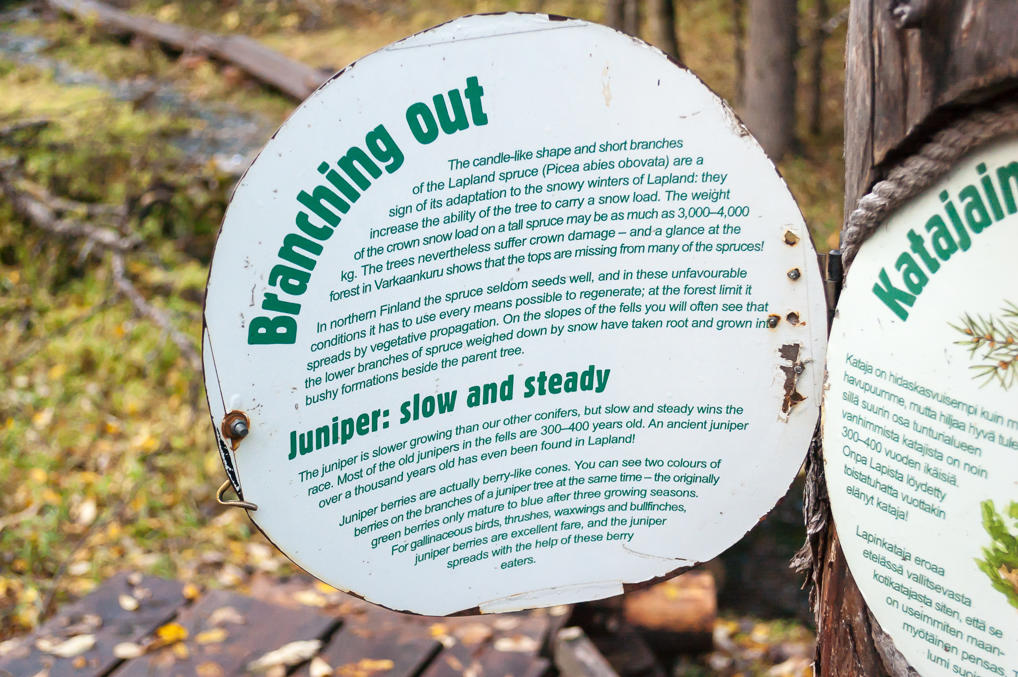
29. Information boards help a bit. All too often they're only in Finnish though, including most of the boards on this trail. I have a beginner Finnish textbook and in fact I got through its first few chapters, but the part with seventeen noun cases or so just stops me cold in my tracks.
30. Well anyway here's some of that juniper the previous board talked about. I realized I probably never ever saw juniper before.
31.
32.
33.
34. Eventually I reached a fork. One of the trails left the brook and went to Kellokas nature center, and the other one continued along, promising to reach Äkäslompolo. I intended to go back to Äkäslompolo, but decided to make a detour to Kellokas. Maybe there's something worthwhile there.
35. Some stairs led up from Varkaankuru ravine. An information table invited to look into this telescope (actually just an empty metal tube without any lenses — I don't know whether it's supposed to be this way) and guess how far away is the top of Kellostapuli Fell, visible right ahead. The answer is less than 1 km, some 700 meters or so. It's a fairly steep fell.
36. After climbing out of the ravine, trail goes through this wetland patch.
37. Some downright odd statues greet you at Kellokas, like this woman flipping the bird.
38. Or this old man hare.
39. The nature center itself was closed, as I suspected. It closes at 5 PM, and it was something closer to 6 PM at the moment. Well at least I knew where it was located — right by Tunturintie between Äkäslompolo and Ylläs skiing center.
40. Backtracking on the same trail. This standard sign denotes the border of a national park or another protected area. Varkaankuru trail is located entirely within Pallas-Yllästunturi National Park limits, although Kellokas and Ylläs skiing center formally aren't.
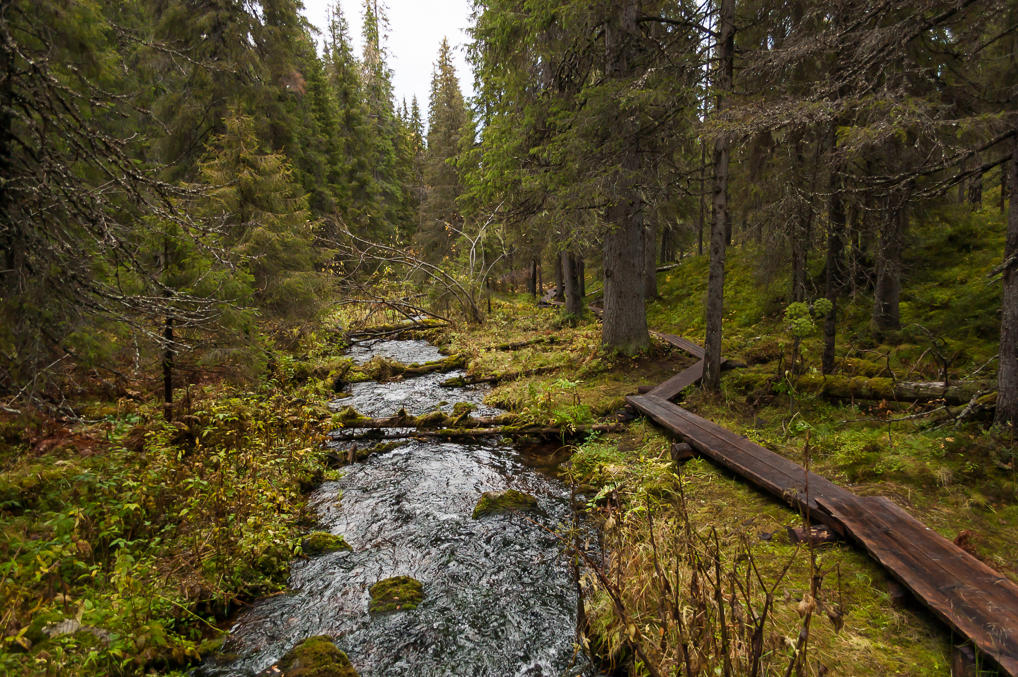
41. The trail from Varkaankuru to Äkäslompolo continues along Varkaanoja brook for a little more.

42. Then there is another fork, and Äkäslompolo trail turns off into a forest, leaving Varkaanoja to flow into Kesänkijoki river in a few hundred meters downstream.
43. Direction signs at forks and orange-topped poles along trails make it very difficult to get lost, but I still did, ending up on this odd water-eroded road leading nowhere. The trail apparently runs along it for a little while, then continues into the forest on the other side of the road, but I didn't realize that at the time. Still, I was close enough to Äkäslompolo that I could just turn on my GPS navigator (which isn't very useful for hiking, as it doesn't know about any trails or terrain, but still can show your position) and find a dirt road which soon got some cabins along it. I ended up walking the last kilometer to my cabin right through the forest between these cabins.
44. I forgot to take any food along, so I was very hungry by the time I got home, and made myself some instant noodles first of all. My cabin was as cozy as ever, but this time I decided to try to make it even cozier by making a fire. There was a basket of firewood, some old papers, and a matchbox. I never had any experience making a fire, but it turned out to be easy enough. I made sure to open the flue at the mansard, as a warning sign said; then I put some papers and small pieces of firewood into the fireplace and struck a match. After the fire began to grow, I started adding larger logs. Eventually I made a mistake somewhere and the fire went out, but I lit it again and from there it all was quite smooth.
I opened a beer and, ignoring Night at the Museum on TV, sat down to watch Citizen Kane, hoping to acquire myself with the classics of cinema (I brought some movies and TV shows on my laptop). It turned out that the basket of firewood I had was enough for just an hour and a half. It was a bit disappointing; I thought it would last for an evening. Anyway, I didn't intend to buy more firewood and light the fireplace again; it was too much bother, and being alone, I didn't really need to create any romantic mood or something.
For the next day, I intended to climb one of the surrounding fells — I didn't really come close to doing that yet. To be continued.

